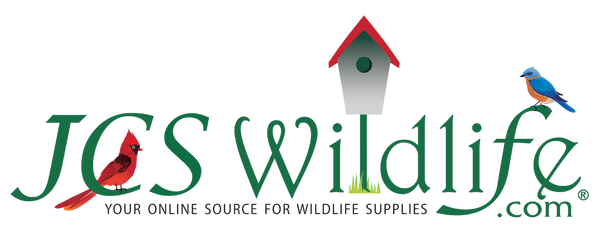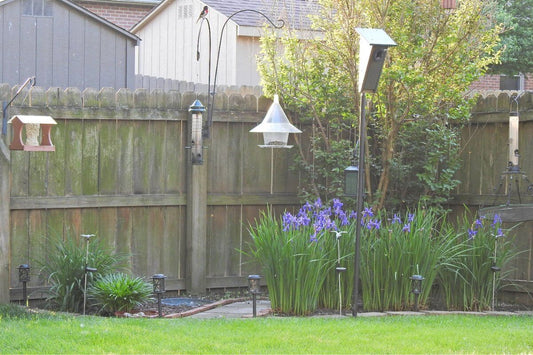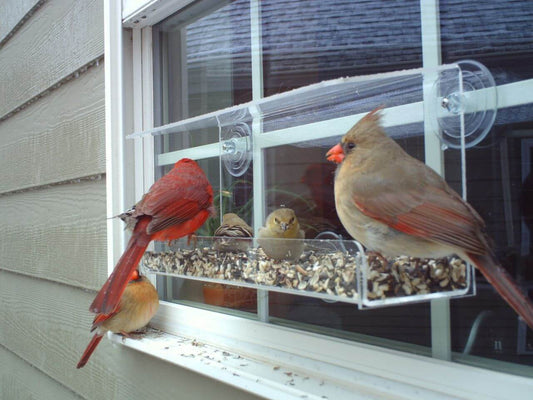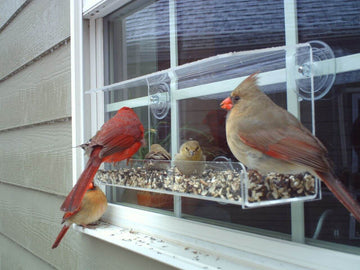-
American Goldfinch (1)
-
American Robin (1)
-
Baltimore Oriole (1)
-
Blue Jay (1)
-
Bluebirds (1)
-
Carolina Wren (1)
-
Chickadee (1)
-
Ducks (1)
-
Starling and House Sparrow (1)
-
House Finch (1)
-
House Wren (1)
-
Hummingbirds (5)
-
Northern Cardinal (1)
-
Northern Mockingbird (1)
-
Nuthatch (1)
-
Owls (3)
-
Tufted Titmouse (1)
-
Woodpeckers (6)
What Bird Feeder is Best For Me? We can help! | JCs Wildlife
Whether you are a seasoned birdwatcher looking to purchase a new feeder or are in the market to buy your very first, you are in the right place. Feeding and watching birds is an enjoyable hobby, but with so many different options on the market for bird feeders, it can be hard to choose the one that is best for you. This article will give you all the details you need to know about eight popular kinds of bird feeders. By evaluating the strengths and weaknesses of each feeder type, you will be equipped to make the best purchasing decision to suit your needs and make your local birds happy.
1: Hopper Feeder
Description: The hopper feeder is one of the most popular varieties on the market. Most often, these are designed to look like a house or cabin, but they come in many different shapes, colors, and styles. This feeder works by gradually draining seed from a reservoir into a tray beneath the main “house” portion. As birds eat the seed from the tray, more seed flows in to replenish the supply and feed hungry visitors.
The Good: The feeder can be mounted or hung depending on your needs. Most of the food is protected from moisture by the enclosed reservoir. Feeders come in small, medium, and large sizes to fit your preferences. In addition, the reservoir system means that you can go days and sometimes weeks without needing to add more food.
The Bad: If this feeder is exposed to the rain, the wet bird food in the tray can clog up the hopper and prevent dry seed from flowing out. If this happens, the jam must be cleared by hand to continue functioning.
What Birds Will Like This Kind of Feeder? Most birds that enjoy popular seed varieties will be attracted to a hopper feeder. Cardinals, jays, and chickadees will certainly be interested. Of course, the kinds of birds you see will vary based on your location.
2: Tube Feeder
Description: Tube feeders are generally long, slender, and clear. Owners simply pour birdseed down the long tube for their winged friends to enjoy. There are two popular versions of tube feeders. The first has feeding ports up and down the tube, often with perches near every port. The second, instead of using ports, drains seed down to a tray at the bottom.
The Good: Like the hopper feeder, the tube variation is usually good at keeping food dry. This is especially true for those that use the feeding port rather than a tray. Another advantage is that, because most tubes are transparent, you will be able to monitor how often to refill the feeder.
The Bad: You will be somewhat limited on where you can place a feeder like this. Chances are you will need to hang it somewhere like a tree branch or shepherd's hook. In addition, they can be hard to clean. Because of the long, slim design, you may have to use a long brush to clear any rotten food or debris.
What Birds Will Like This Kind of Feeder? Tube feeders tend to attract smaller bird varieties like finches, for example. Larger birds will find it difficult to eat while standing on the perches or narrow feeding tray.
3. Suet Feeder
Description: Suet feeders are unique, both in the way that they look and the kind of feed that they are designed to hold. They typically look like a square-shaped metal cage. Often, the metal bars on the feeder are dipped in a plastic-like substance to prevent rusting and protect birds. The feeders have a door that people can use to put suet bricks rather than loose seed. Suet ingredients vary, but they most often consist of animal fat, fruit, and seeds. Birds can peck away at the brick, biting off small pieces. Birds grasp the metal cage rather than sitting on a perch or tray to enjoy the suet.
The Good: There are plenty of options on where you can hang a suet feeder. They can be mounted, hung, or simply placed on a stump, porch rail, or another solid surface. Also, the unique shape allows you to snuggly store suet cakes instead of leaving them unprotected elsewhere.
The Bad: Unfortunately, while suet feeders are great at attracting beautiful birds, they also are prone to attract other critters that may be undesirable. Many owners of such feeders report that squirrels also enjoy suet. Never Melt Suet is a great option when you live in warmer climates, so consider that during the summer months!
What Birds Will Like This Kind of Feeder? Since suet contains a higher calorie count than regular seed, very active birds will be drawn to suet feeders. Woodpeckers, wrens, and chickadees are examples of such birds.
4. Tray Feeder
Description: Feeding birds with a tray feeder is simple and effective. The design consists of a flat trough for food that can be placed flat on an even surface or suspended in the air. The trough is often made from plastic, although wooden styles are also available. Food sits in the tray and birds can either perch on the edges to eat or jump in the tray. These feeders are often rectangular, but can also be square or round.
The Good: This tray feeder’s simplicity is its largest advantage. You can put nearly any kind of seed in the feeder and easily clean it as needed.
The Bad: The trough-style provides virtually no protection from the elements, meaning that food is likely to go bad because of rain and snow. However, there are some options for feeders that provide roofs, making the “Fly Thru Feeders”, so look into that as an alternative!
What Birds Will Like This Kind of Feeder? Since this feeder is flexible as to what kind of food you fill it with, it has the potential to attract many different kinds of birds.
5. Fruit Feeder
Description: Fruit feeders are unique in that, as the name suggests, bird enthusiasts place fresh fruit in them for birds to enjoy. This is different from typical feeders that are made for nuts, seed, and suet-based food. Fruit feeders make it easy to either place fruit in a tray or skewer pieces on wooden or metal dowels. Owners of this kind of feeder often enjoy stocking the device with apples, oranges, and grapes, although all sorts of fruit can be used.
The Good: The fruit feeder allows you to avoid expensive seed and nut mixes. Instead, you can feed birds with the fruit scraps you collect from your kitchen. In addition, as we will discuss below, the fruit will attract birds that might not be attracted by conventional feed.
The Bad: Feeding birds with fresh fruit can be much messier than putting out dry foods. There is also a higher potential for waste in a fruit feeder because as birds peck the fruit, some will fall on the ground. In addition, the sugar content in the fruit is sure to draw ants and other insects. Be aware of these drawbacks before buying.
What Birds Will Like This Kind of Feeder? The birds that you attract with this feeder will depend, in part, on what kind of food you put in it. Orioles, tanagers, and thrushes, however, are known to enjoy many different fruit varieties.
6. Window Feeder
Description: A window feeder is great for new and seasoned bird watchers alike. The design of this variety allows you to see birds up close and personal. With the aid of suction cups, owners can attach the feeder to any window. Typically, they are designed similar to a hopper feeder, so you can fill a reservoir only as needed instead of every day.
The Good: If you are used to seeing birds from afar, or even if you enjoy looking at them with a set of binoculars, a window feeder is a great way to get up close and personal with your winged visitors. In addition, they are often easy to maintain since they are so close to your living space.
The Bad: Some shy birds might stay away from your windows if they can see activity or hear noise coming from inside your space. Another potential negative that some users have reported is that birds sometimes run into the windows when they are trying to examine the feeder. This can frighten people on the other side of the window and also potentially injure the bird. A potential fix to this is “Window Alerts”, which are UV stickers that birds see, allowing them to recognize clear surfaces and avoid crashing into them.
What Birds Will Like This Kind of Feeder? Common varieties such as cardinals, finches, and perhaps even sparrows will enjoy food from a feeder like this.
7. Nyjer Feeder
Description: Nyjer is a very small kind of birdseed that is popular among birdwatchers. Many types of feeders are unable to accommodate this tiny food, which is prone to fall out of standard feeders due to being extremely lightweight. Nyjer feeders solve this problem, though, with innovative tube and sock designs. The tube format is very similar to a regular tube feeder, except the feeding ports are much smaller than the standard sizes. The sock variety is made from finely woven mesh or cloth, allowing birds to pull seed from the sock without waste.
The Good: The upside of this feeder type is simple, being one of the few options on the market for those who enjoy using nyjer. Thanks to clever designs, nyjer feeders allow people to put out a seed variety that they would not be able to otherwise.
The Bad: In some ways, nyjer is a difficult food. Birds like it for its oily texture and are less likely to eat it once dried out. If you put too much seed in a feeder or place your feeder in a low-traffic area, the seed might go bad before the birds can enjoy it. Also, nyjer feeders are less versatile than other feeders and can only accommodate the smallest seeds.
What Birds Will Like This Kind of Feeder? Finches, doves, and even woodpeckers enjoy nyjer feeders, but many other bird varieties may also enjoy visiting.
8. Nectar and Liquid Feeder
Description: Feeders that hold nectar and liquid are unique on this list for one simple reason: all of the other feeders accommodate solid food. This type, however, holds liquid food. In terms of appearance, these usually have a glass or plastic reservoir to hold the juice with small drinking ports at the bottom. Because the birds that enjoy this type of food are usually drawn to this color, most nectar feeders are red.
The Good: Nectar feeders give people the opportunity to see birds that they would not be able to otherwise. In addition, you can make cheap nectar at home with a simple recipe of water and sugar. This is far cheaper than buying traditional seed mixes from a store.
The Bad: Feeding birds nectar can also attract bugs like ants and bees. Also, people considering purchasing a feeder like this should be aware that they need to be cleaned more often than other types. Because the liquid is often exposed to sunlight, the container can grow bacteria that can be harmful to birds.
What Birds Will Like This Kind of Feeder? Hummingbirds are the most common birds that will enjoy a nectar feeder. Because they move so quickly, they need the sugar-based energy that nectar provides.
In Review:
As you can see, there are bird feeders, like the audubon glass bird feeder, that fit every person’s needs.. When considering what kind of feeder you need, consider where you would like to place the feeder, what kind of feed you would like to use, and what sorts of birds you would like to attract. Answering these questions will allow you to make an informed buying decision.
No comments








0 comments